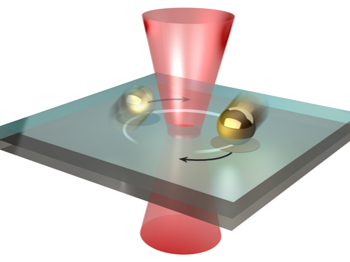In this interview, AZoNano discusses the development of a novel solid-state optical nanomotor, which is driven by light. This nanomotor is the first of its kind, and could have significant applications for the design of power sources in a range of existing and future technologies.
Please could you introduce yourself and tell us about your current position and research activities?
I am a Postdoctoral Scholar in the Department of Mechanical Engineering at the University of California, Berkeley, working with Prof. Costas P. Grigoropoulos. I received Ph.D. in Materials Science and Engineering from The University of Texas at Austin under the supervision of Prof. Yuebing Zheng in 2021, and B.Sc. in Applied Physics from the University of Science and Technology of China in 2017.
My research interest lies in general optics and photonics, particularly in optical manipulation, photonic materials, light-matter interactions, and optical microscopy and spectroscopy.
What are nanomotors, and what role do they play in devices such as miniature power sources?
Nanomotors are nanoscale devices that can convert different forms of energy into mechanical work. They can be used for various purposes in miniatured devices, such as the transport of nanoscale objects and electricity generation.
Could you summarize the results of your recent research?
Essentially, our recent study proposes a new type of light-driven nanomotors that can rotate on a solid substrate without fluidic environments. The main technical component to highlight is the solid-state operation, as most previous reports on nanomotors are operated in liquid environments.
Nanomotor Rotation
© CockrellSchool/YouTube.com
One aspect of the nanomotor’s design is cited as particularly impactful in this breakthrough. Could you discuss the thin film's design and its role?
Since nanoparticles are usually firmly bonded with the substrate by strong van der Waals forces, it is difficult to realize the manipulation or rotation of nanoparticles on solid substrates.
We introduce the thin film with phase-change properties to overcome this challenge. It is located between the substrate and nanoparticles to modulate the particle-substrate interactions. Specifically, under light illumination, the phase change of the thin film can reduce the van der Waals friction force between nanoparticles and the substrate to enable the light-driven motion of nanomotors.
Previously, solid-state motors resided in solution. What impact does this have on the design of next-generation devices? Why is a solid-state morphology preferred?
There are two reasons to develop solid-state nanomotors. First, random Brownian motion in liquids will affect the accurate control of nanomotors. Especially, Brownian motion becomes more dominant for nanoscale objects.
Second, solid-state nanomotors are compatible with the current silicon electronics and can be used for on-chip devices, while nanomotors in liquids cannot.

Spinning Motors © The University of Texas At Austin
As part of your investigations, you explored the light-driven rotation of different asymmetric nanoparticle geometries. What impact does nanoparticle geometry have on the functionality of the nanomotor, and how might this affect the feasibility of its construction?
In our work, this nanomotor is driven by thermocapillary forces, which are generated due to the asymmetric nanoparticle geometry. Spherical particles cannot be used for this nanomotor. The geometry of the nanoparticle can be designed and optimized to construct nanomotors with better performance.
Gold nanoparticles were chosen to construct this nanomotor; why was this?
Gold nanoparticles have high light absorption to convert light to heat, therefore to enable the phase change of the thin film. Second, gold particles are also promising for many applications in many photonic, optoelectronic, and optomechanics devices.
In your opinion, how might the design of nanomotors change in the next 10-15 years? Are there any major barriers that limit the further development of this nanotechnology?
I believe the miniaturization of nanomotors will continue to the molecular scale. More new mechanisms will also be discovered and exploited to develop nanomotors. In addition, on such a small scale, the reliable control of these nanomotors will still be a great challenge and focus of research. Other barriers include the imaging and real-time monitoring of these small motors.
What are the next steps of this research? Are there any future directions you are striving towards?
We will work on enhancing the performance of these nanomotors, including optimizing the geometry to make them more stable and controllable with higher energy conversion efficiency. We are also trying to integrate this motor with on-chip devices for more advanced functions.
About Jingang Li, Ph.D.
 Jingang Li is a Postdoctoral Scholar in the Department of Mechanical Engineering at the University of California, Berkeley, working with Prof. Costas P. Grigoropoulos. His current research focuses on investigating light-matter interactions at the nanoscale with optical microscopy and spectroscopy.
Jingang Li is a Postdoctoral Scholar in the Department of Mechanical Engineering at the University of California, Berkeley, working with Prof. Costas P. Grigoropoulos. His current research focuses on investigating light-matter interactions at the nanoscale with optical microscopy and spectroscopy.
Jingang has published 14 first-authorship papers in prominent scientific journals, including Nature Communications, Science Advances, Chemical Reviews, Advanced Materials, Nano Letters, ACS Nano, Advanced Functional Materials, etc. His research was highlighted more than 100 times in science news, such as UT News, EurekAlert!, The Daily Texan, Optics & Photonics News, Nanowerk, Phys.org.
He is a recipient of MRS Graduate Student Award, Chinese Government Award for Outstanding Self-Financed Students Abroad, UT Austin University Graduate Continuing Fellowship, and Ben Streetman Prize.
Disclaimer: The views expressed here are those of the interviewee and do not necessarily represent the views of AZoM.com Limited (T/A) AZoNetwork, the owner and operator of this website. This disclaimer forms part of the Terms and Conditions of use of this website.